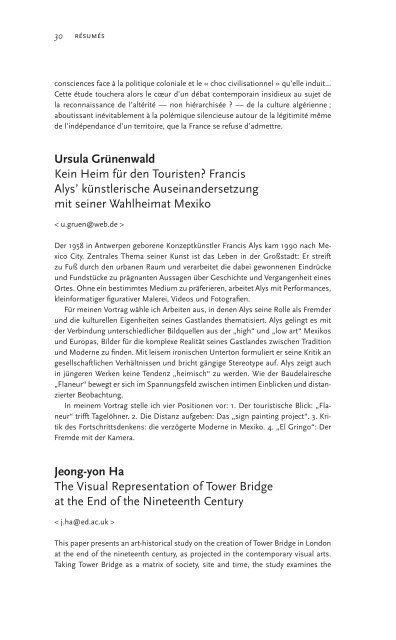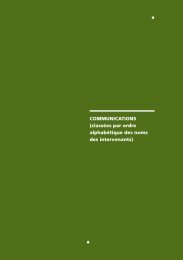Programme et Abstracts (PDF) - Réseau International pour la ...
Programme et Abstracts (PDF) - Réseau International pour la ...
Programme et Abstracts (PDF) - Réseau International pour la ...
Create successful ePaper yourself
Turn your PDF publications into a flip-book with our unique Google optimized e-Paper software.
30<br />
résumés<br />
consciences face à <strong>la</strong> politique coloniale <strong>et</strong> le « choc civilisationnel » qu’elle induit...<br />
C<strong>et</strong>te étude touchera alors le cœur d’un débat contemporain insidieux au suj<strong>et</strong> de<br />
<strong>la</strong> reconnaissance de l’altérité — non hiérarchisée ? — de <strong>la</strong> culture algérienne ;<br />
aboutissant inévitablement à <strong>la</strong> polémique silencieuse autour de <strong>la</strong> légitimité même<br />
de l’indépendance d’un territoire, que <strong>la</strong> France se refuse d’adm<strong>et</strong>tre.<br />
Ursu<strong>la</strong> Grünenwald<br />
Kein Heim für den Touristen? Francis<br />
Alys’ künstlerische Auseinanders<strong>et</strong>zung<br />
mit seiner Wahlheimat Mexiko<br />
< u.gruen@web.de ><br />
Der 1958 in Antwerpen geborene Konzeptkünstler Francis Alys kam 1990 nach Mexico<br />
City. Zentrales Thema seiner Kunst ist das Leben in der Großstadt: Er streift<br />
zu Fuß durch den urbanen Raum und verarbeit<strong>et</strong> die dabei gewonnenen Eindrücke<br />
und Fundstücke zu prägnanten Aussagen über Geschichte und Vergangenheit eines<br />
Ortes. Ohne ein bestimmtes Medium zu präferieren, arbeit<strong>et</strong> Alys mit Performances,<br />
kleinformatiger figurativer Malerei, Videos und Fotografien.<br />
Für meinen Vortrag wähle ich Arbeiten aus, in denen Alys seine Rolle als Fremder<br />
und die kulturellen Eigenheiten seines Gast<strong>la</strong>ndes thematisiert. Alys gelingt es mit<br />
der Verbindung unterschiedlicher Bildquellen aus der „high“ und „low art“ Mexikos<br />
und Europas, Bilder für die komplexe Realität seines Gast<strong>la</strong>ndes zwischen Tradition<br />
und Moderne zu finden. Mit leisem ironischen Unterton formuliert er seine Kritik an<br />
gesellschaftlichen Verhältnissen und bricht gängige Stereotype auf. Alys zeigt auch<br />
in jüngeren Werken keine Tendenz „heimisch“ zu werden. Wie der Baude<strong>la</strong>iresche<br />
„F<strong>la</strong>neur“ bewegt er sich im Spannungsfeld zwischen intimen Einblicken und distanzierter<br />
Beobachtung.<br />
In meinem Vortrag stelle ich vier Positionen vor: 1. Der touristische Blick: „F<strong>la</strong>neur“<br />
trifft Tagelöhner. 2. Die Distanz aufgeben: Das „sign painting project“. 3. Kritik<br />
des Fortschrittsdenkens: die verzögerte Moderne in Mexiko. 4. „El Gringo“: Der<br />
Fremde mit der Kamera.<br />
Jeong-yon Ha<br />
The Visual Representation of Tower Bridge<br />
at the End of the Nin<strong>et</strong>eenth Century<br />
< j.ha@ed.ac.uk ><br />
This paper presents an art-historical study on the creation of Tower Bridge in London<br />
at the end of the nin<strong>et</strong>eenth century, as projected in the contemporary visual arts.<br />
Taking Tower Bridge as a matrix of soci<strong>et</strong>y, site and time, the study examines the<br />
social, spatial and historical aspects of the architecture through a close analysis of<br />
its visual representation. The principal source materials of my study are William<br />
Lionel Wyllie’s 1895 Royal Academy exhibit The Opening of Tower Bridge (Guildhall Art<br />
Gallery, London) and Henri Lanos’s illustration for the Graphic (20 February 1892),<br />
The Present State of the Tower Bridge—A View from the Tower Pier, Surrey Side. These<br />
works represented different aspects not only of Tower Bridge but also of London,<br />
which I consider in terms of British imperialism and the particu<strong>la</strong>r modernity of the<br />
imperial capital. In analysing the material I address the issues of changing imperial<br />
economy, technological change and Victorian aesth<strong>et</strong>ic values, and examine the ways<br />
in which those issues are represented in the visual arts through different artistic<br />
aims, means and modes. The specific questions raised in the paper include: Why did<br />
the artist choose these particu<strong>la</strong>r sights? What can his specific perspective of viewing<br />
Tower Bridge mean? What aspects of the bridge and its surrounding are emphasised<br />
in his representation? What ideas and subjects are projected via means of viewpoint,<br />
colour and composition? In answering these questions I shall explore the role of the<br />
visual representation of Tower Bridge at the turn of the twenti<strong>et</strong>h century.<br />
Dominic Hardy<br />
Quand les Hurons recevaient <strong>la</strong><br />
représentation de <strong>la</strong> France<br />
< hardy.dominic@uqam.ca ><br />
résumés 31<br />
Il s’agira d’examiner le lieu fécond <strong>et</strong> instable qu’est l’historiographie autour d’une<br />
toile non signée <strong>et</strong> non datée, connue sous le titre (mais ce<strong>la</strong>, non de manière<br />
universelle) de La France apportant <strong>la</strong> foi aux Hurons de <strong>la</strong> Nouvelle France (Musée<br />
des Ursulines, Québec), afin d’interroger l’évolution du recours à c<strong>et</strong>te œuvre dans<br />
l’histoire des origines de l’art en Nouvelle-France, au Canada <strong>et</strong> en Amérique du<br />
Nord. Créée vers <strong>la</strong> fin du XVII e siècle par une main qu’on a parfois identifiée à celle<br />
du peintre récoll<strong>et</strong> C<strong>la</strong>ude François, dit Frère Luc (1614–1685), qui était en mission<br />
en Nouvelle-France en 1670–1671, l’œuvre m<strong>et</strong> en composition une figure Huronne<br />
qui reçoit de <strong>la</strong> figure symbolique de <strong>la</strong> France — dans un paysage <strong>la</strong>urentien<br />
couronné par l’apparition dans les nuages de <strong>la</strong> Sainte Trinité <strong>et</strong> des protecteurs du<br />
Canada —, un tableau qui représenterait <strong>la</strong> Sainte-Famille en compagnie des Saints<br />
jésuites François Xavier <strong>et</strong> Ignace de Loyo<strong>la</strong>. On y a lu un discours portant sur <strong>la</strong><br />
représentation de <strong>la</strong> représentation elle-même, comme symbole de <strong>la</strong> transmission<br />
de <strong>la</strong> foi <strong>et</strong> de <strong>la</strong> civilisation françaises, voire européennes, <strong>et</strong> ce<strong>la</strong> dans le contexte<br />
d’une mission de <strong>la</strong> Contre-Réforme qui, en aidant à inventer un Canada quelque peu<br />
fictif, inventerait en même temps une France non moins fictive. Tableau-artéfact des<br />
origines de l’art européen en Amérique du Nord, La France apportant <strong>la</strong> foi... participe<br />
aux origines <strong>et</strong>, par <strong>la</strong> suite, aux révisions de l’histoire de l’art au Canada ; on en a fait<br />
une lecture « marinienne », on l’a approprié aux besoins des origines des arts des<br />
États-Unis. Nous voudrons donc revenir sur le tableau <strong>et</strong> l’ensemble des questions<br />
irrésolues qui l’entourent <strong>pour</strong> réfléchir à <strong>la</strong> dimension mythique — à juste titre <strong>pour</strong><br />
une œuvre « méta-originaire » ? — qui semble désormais l’investir.



